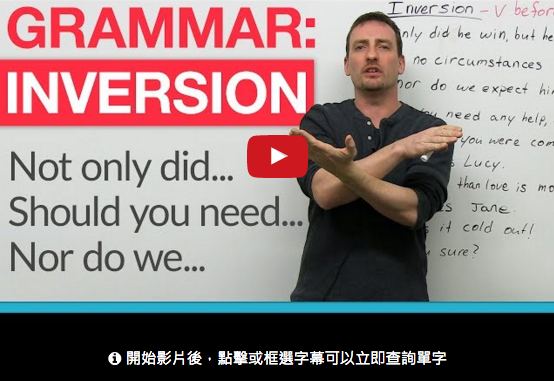面對考題中的倒裝句總是看不懂?
小 V 整理了運用倒裝句的各種情景
搭配清晰的文法解析
馬上搞懂倒裝句文法!

話不多說,看影片最清楚:
倒裝句文法大解析! (English Grammar – Inversion: ‘Had I known…’, ‘Should you need…’)

以下整理幾種你可能會用到「倒裝句」這種句型的情境:
1. 表達驚歎、強調特定詞語
最簡單的倒裝句就是主語與動詞的順序調換了。如果有助動詞的句子,順序就會變成:助動詞→主語→動詞。如果是想要大力強調句子中的「形容詞」,順序就該是:形容詞→動詞→主語。
基本的倒裝句只有主詞與動詞的調換:
原裝:
主語 + 動詞
Subject + verb
(Example)
I (subject) + am (verb) + glad to see you.
I am glad to see you.
我高興看到你。
倒裝:
動詞 + 主語
Verb + subject
(Example)
Am (verb) + I (subject) + glad to see you!
Am I glad to see you!
真高興看到你。
有副詞的話主語與動詞就交換位子:
原裝:
主語 + 助動詞 + 動詞
Subject + auxiliary verb + verb
(Example)
It (subject) + is (auxiliary verb) + raining (verb) cats and dogs outside.
It is raining cats and dogs outside.
外面傾盆大雨。
倒裝:
助動詞 + 主語 + 動詞
Auxiliary verb + subject + verb
(Example)
Is (auxiliary v) + it (subject) + raining (verb) cats and dogs outside.
Is it raining cats and dogs outside.
外面真是傾盆大雨。
要強調形容詞時,形容詞與主詞換位子的句子:
原裝:
主語 + 動詞 + 形容詞
Subject + verb + adjective
(Example)
The scenery of the Taipei 2010 Flora Expo (subject) + was (verb) + so beautiful (adjective), the visitors were moved by the dazzling flowers.
The scenery of the Taipei 2010 Flora Expo was so beautiful, the visitors were moved by the dazzling flowers.
台北2010花博的風景如此美麗,參觀者被燦爛的花感動。
倒裝:
形容詞 + 動詞 + 主語
Adjective + verb + subject
(Example)
So beautiful (adjective) + was (verb) + the scenery of the Taipei 2010 Flora Expo (subject), the visitors were moved by the dazzling flowers.
So beautiful was the scenery of the Taipei 2010 Flora Expo, the visitors were moved by the dazzling flowers.
如此美麗的台北2010花博風景,參觀者被燦爛的花感動。
2. 強調時間的觀念
時間副詞 (time adverbial) 通常是出現在主語或動詞的後面。可是如果把它搬到句子的最前面,會大幅度的把注意力拉到相關事件的時間概念。就像是講故事給小朋友聽的時候,如果加強「從來沒有」、「經常」、「難得」、「事到如今」、「只有這個時候」的用語,會讓聽到的人對故事中事情發生的順序或頻率印象深刻。
強調 “only after” 的句子:
原裝:
主語 + 動詞 + 時間副詞
Subject + verb + time adverbial
(Example)
A session of yoga practice (subject) + is (verb) + completely finished only after (time adverbial) +the corpse pose (final relaxation).
A session of yoga practice is completely finished only after the corpse pose (final relaxation).
一段瑜珈練習要到「屍式」(大休息)後才完全結束。
倒裝:
時間副詞 + 動詞 + 主語
Time adverbial + verb + subject
(Example)
Only after (time adverb) + the corpse pose (final relaxation) + is (verb) +session of yoga practice (subject) + completely finished.
Only after the corpse pose (final relaxation) is a session of yoga practice completely finished.
要到「屍式」(大休息)之後一段瑜珈練習才完全結束。
強調 “around the clock” 的句子:
原裝:
主語 + 動詞 + 時間副詞
Subject + verb + time adverbial
(Example)
The web developer (subject) + worked (verb) + around the clock (time adverbial) + to attract more viewers.
The web developer worked around the clock to attract more viewers.
網站開發人員為了吸引更多的觀眾不停的工作。
倒裝:
時間副詞 + 動詞 + 主語
Time adverbial + verb + subject
(Example)
Around the clock (time adverbial) + the web developer (subject) + worked (verb) + to attract more viewers.
Around the clock the web developer worked to attract more viewers.
不停的工作的網站開發人員是為了吸引更多的觀眾。
調動 “until after” 的位子來整理文字中的時間邏輯:
原裝:
主語 + 助動詞 + 動詞 + 連接詞 + 主語 + 助動詞 + 動詞 + 時間副詞 + 相關事件
Subject + auxiliary verb + verb + conjunction (that) + subject + auxiliary verb + time adverbial + related event
(Example)
I (subject) + didn’t (auxiliary verb) + realize (verb) + that (conjunction), + I (subject) + didn’t (auxiliary verb) + have (verb) any money + until after (time adverbial) + I ordered coffee at the corner coffee shop (related event).
I didn’t realize that, I didn’t have any money until after I ordered coffee at the corner coffee shop.
我在巷口的咖啡店點了咖啡之後才發現我沒有錢。
以上的例句的開頭是 “I didn’t” ,因為時間副詞 “until after” 在中段才出現。與後段的事項比較,在時間副詞之前所表達的是在那時候還沒有發生的事情(realize that I didn’t have any money)。
倒裝:
時間副詞 + 相關事件 + 主語 + 動詞 + 助動詞 + 主語 + 動詞 + 連接詞 + 主語 + 助動詞 + 動詞
Time adverbial + related event + subject + verb + auxiliary verb + subject + verb + conjunction (that) + subject + auxiliary verb + verb
(Example)
Not until (time adverbial) + I (subject) + ordered coffee at the corner coffee shop (related event) + did (auxiliary verb) + I (subject) + realize (verb) + that (conjunction), + I didn’t (auxiliary verb) + have (verb) any money.
Not until I ordered coffee at the corner coffee shop did I realize that, I didn’t have any money.
直到我在巷口的咖啡店點了咖啡之後才發現我沒有錢。
以上的例句一開頭就是時間副詞 “until after”,而中段是 “did I realize”。因為時間副詞一出現,就把句子的時間概念給帶到相關的地方,表示從時間副詞之後 “I didn’t have any money” 的事項已經被發現了。與原裝的句子比較的話,就可以看得出來不同說法的差異,可是兩者表達的是一模一樣意思。細微的比較凸顯英文文法直線條的邏輯性,值得學英文的人多注意!
3. 凸顯地點副詞
用來表達地點的副詞 (place adverbial) 通常也是出現在主語或動詞的後面。把它搬到句子的最前面,也會把注意力拉到「相關事件發生的地方」。
強調 “under the stairs” 的句子:
原裝:
主語 + 動詞 + 地點副詞
Subject + verb + place adverbial
(Example)
The homeless kittens (subject) + slept (verb) + under the stairs (place adverbial).
The homeless kittens slept under the stairs.
無家可歸的小貓咪們睡在樓梯下面。
倒裝:
以下這兩種都是可以使用的倒裝句型:
地點副詞 + 動詞 + 主語
Place adverbial + verb + subject
地點副詞 + 主語 + 動詞
Place adverbial + subject + verb
(Example)
Under the stairs (place adverbial) + the homeless kittens (subject) + slept (verb).
Under the stairs the homeless kittens slept.
樓梯下面睡著無家可歸的小貓咪們。
強調 “onto my memory” 的句子:
原裝:
主語 + 動詞 + 地點副詞
Subject + verb + place adverbial
(Example)
The image of him laughing (subject) + imprinted (verb) + onto my memory (place adverbial).
The image of him laughing imprinted onto my memory.
他大笑的畫面烙印笑在我的記憶。
倒裝:
地點副詞 + 動詞 + 主語
Place adverbial + verb + subject
(Example)
Onto my memory (place adverbial) + imprinted (verb) + the image of him laughing (subject).
Onto my memory imprinted the image of him laughing.
我的記憶中烙印了他大笑的畫面。
4. 條件句 (conditional sentences) 的另一種面貌
各種不同 “If” 開頭的條件句是英文文法的必學的項目。可是很多人都不知道如果把 “had” 或者 “should” 搬到句子的最前面,”if” 就不用出現了。雖然換了臉的條件句不是普遍的用法,也有一點嚴肅的感覺,但學會後你就多一種在寫作時可以使用的句型了。
“Should” 代替了 “if”:
原裝:
如果 + 主語 + 現在簡單式
If + subject + simple present
(Example)
If + you (subject) + need (simple present) any assistance, please call customer service.
If you need any assistance, please call customer service.
如果您需要任何協助,請打客服。
倒裝:
萬一 + 主語 + 現在簡單式
Should + subject + simple present
(Example)
Should + you (subject) + need (simple present) any assistance, please call customer service.
Should you need any assistance, please call customer service.
萬一您需要任何協助,請打客服。
把 “had” 調到前面就不需要 “if”:
原裝:
[A事件]
如果 + 主語 + 過去完成式
If + subject + past perfect
[B事件]
主語 + 完成條件式 (當初就會) + 過去分詞
Subject + perfect conditional (would have) + past participle
(Example)
If + I (subject) + had known (past perfect) everyone in Taipei would be dinning out on Friday night, I (subject) + would have (perfect conditional) + called (past participle) the restaurant to make a reservation.
If I had known everyone in Taipei would be dinning out on Friday night, I would have called the restaurant to make a reservation.
如果當初我知道台北市每一個人都會在星期五晚上出來吃飯,我就會打電話定位了。
倒裝:
[A事件]
當初要是 + 主語 + 過去完成式
Had + subject + past perfect
[B事件]
主語 + 完成條件式 (當初就會) + 過去分詞
Subject + perfect conditional (would have) + past participle
(Example)
Had + I (subject) + known (past perfect) everyone in Taipei would be dinning out on Friday night, I (subject) + would have (perfect conditional) + called (past participle) the restaurant to make a reservation.
Had I known everyone in Taipei would be dinning out on Friday night, I would have called the restaurant to make a reservation.
我當初要是知道台北市每一個人都會在星期五晚上出來吃飯,我就會打電話定位了。
*延伸*
忘記條件句?這邊解釋得很清楚:【英文文法一看就懂】困擾超久的「條件句」時態句型大解析!
5. 調動相關連接詞的位置
“Either”、“neither”、“nor” 是英文中常出現的相關連接詞 (correlative conjunction) 。在否定句中,如果有兩個主語,通常只要在前段表示否定,在後段再用 “either” 來表達「也沒有」,就可以表達兩者都是否定的意思。可是如果簡單的倒裝一下,就可以轉換句子的形態與語氣,也讓大家學到另一種句型了。
“Either” 與 “neither” 巧妙的對換:
原裝:
[A事件]
主語 + 否定
Subject A + negative
[B事件]
主語 + 否定 + 「也不」相關連接詞
subject B + negative + (either) correlative conjunction
(Example)
The coffee shop (subject A) + is not open on Easter Sunday, and the pharmacy (subject B) + is not open + either (correlative conjunction).
The coffee shop is not open on Easter Sunday, and the pharmacy is not open either.
咖啡店在復活節不營業,藥店也不會營業。
倒裝:
[A事件]
主語 A + 否定
Subject A + negative
[B事件]
「都不」相關連接詞 + 認定 + 主語 B
(neither) correlative conjunction + positive + subject B
(Example)
The coffee shop (subject A) + is not (negative) open + on Easter Sunday, and neither (correlative conjunction) + is (positive) + the pharmacy (subject B).
The coffee shop is not open on Easter Sunday, and neither is the pharmacy.
咖啡店在復活節不營業,而同樣不營業的還有藥房。
*延伸*
副詞中的 “so” 在倒裝句中也有獨特的用法。
原型:
My companion and I both felt starving after hiking up the hill.
爬山後我與同伴都好餓。I was starving after hiking up the hill, and my companion was also very hungry.
爬山後我好餓,我的同伴也餓到不行。
倒裝型:
I was starving after hiking up the hill, so was my companion.
爬山後我好餓,我的同伴也是。
6. 在描寫對話時,增加戲劇化效果
就像中文文學中對話的情景,描寫對話時,不需要總是先寫冒號 (colon),再加引號 (quotation marks)。英文也可以對話出現之後,再表示是誰說的。如果把描寫對話的句子倒裝一下,把動詞搬到主語的前面,也可以讓句型更生動活潑。
不同的對話形式描寫了不同的態度與幽默:
原型:
引言 + 主語 + 動詞
Quotations + subject + verb
(Example)
“I can’t believe you guys drank all the coffee,” (quotations) + he (subject) + said (verb).
“I can’t believe you guys drank all the coffee,” he said.
「我無法相信你們喝掉了所有的咖啡。」他說道。
(Example)
“Will you make some coffee for me?” (quotations) + The half-asleep man (subject) + asked (verb) his girlfriend.
“Will you make some coffee for me?” The half-asleep man asked his girlfriend.
「妳可以煮一點咖啡給我喝嗎?」半睡半醒的男士問他的女朋友。
倒裝型:
引言 + 動詞 + 主語
Quotations + verb + subject
(Example)
“Please tell me there is coffee,” (quotations) + said (verb) + the first customer (subject) at the bakery at six in the morning.
“Please tell me there is coffee,” said the first customer at the bakery at six in the morning.
「請告訴我還有咖啡」,烘培店在早上六點的第一個客人這麼說。
(Example)
“Is there anymore coffee?” (quotations) + Asked (verb) + the grumpy man (subject) who slept until noon.
“Is there anymore coffee?” Asked the grumpy man who slept until noon.
「還有咖啡嗎?」睡到中午、有點暴躁的男士問道。
*補充*
代名詞不適合在描寫對話中用來倒裝,因為如果說 “Said he.”、”Said she.”、”Said I” 聽起來看起來都太怪了,就像如果平常講話時對方突然把文學的文言文搬出來,大家都會有點搞不清楚怎麼回事。
再看一次影片的詳解,印象會更深刻哦:
倒裝句文法大解析! (English Grammar – Inversion: ‘Had I known…’, ‘Should you need…’)
迫不及待想馬上開始練習嗎?
快打開 VoiceTube App 練英文!
✦ 立即下載 >>> https://bit.ly/myenglishissogood
英文單字不要硬背! 藉由 VoiceTube App 看影片,不會的單字反覆聆聽,加上單字測驗練習,聽寫齊下,立刻熟記!
文/王傳瑄
圖/Matthew Wiebe, CC Licensed
作者簡介/VoiceTube看影片學英語
學英文不是艱難的任務,而是一種融入生活的自然態度,今天起,丟掉厚重的教科書,每日鎖定VoiceTube看影片學英語官方部落格,給自己一個流利『用』英語的機會!
